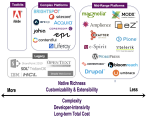Clickability shows how not to write a white paper
White papers are not something we typically critique or comment on, but Clickability's new white paper, billed on their website as "What Vignette is Not Telling You," does, in fact, require special comment.
The paper's stated goal "is to provide strategic data and insights that will help in your decision-making process regarding Web Content Management." But the four-page phillipic quickly reveals itself as little more than an arrogant, shrill, and sometimes factually incorrect attack on Vignette and its new parent company, Open Text.
Many of the criticisms made in the white paper (involving upgrade pain, migration pain, slow product innovation, high licensing costs) will be familiar to any student of Vignette-bashing. There's truth in some of the claims, certainly, but it's a dated kind of truth, applying mostly to the Vignette of 2002 or 2004.
The truth is that Vignette has made a good-faith effort, over the past two years, to address many of the well-known criticisms about its products. Along the way, they've managed to produce a significant number of new products and rolled out non-trivial updates to existing ones. They've also become more competitive on pricing, and have clearly gotten the message on upgrade pain. So to drag out the standard laundry list of complaints about the Vignette of Olde and paint the company (yet again) as an innovation-averse, customer-ignoring purveyor of overpriced, outmoded goods is like beating a horse that died two years ago.
Of course, the positive changes that have happened to Vignette and its product line in 2008-2009 are of little comfort to you if you're still running the old V5 or V6. There will be pain involved in moving to a new or different platform. And that's clearly a selling opportunity for vendors like FatWire and Clickability. But those V5/V6 customers are already well aware of their dilemma -- and what does it say about the vendor that pursues that narrow group by painting an entire competing vendor as incompetent?
There are other problems with the white paper. Clickability associates a quote involving "lipstick on a pig" with CMSWire in one part of the paper and then (inaccurately) with CMS Watch in another. In truth, the lipstick statement actually comes from an anonymous comment at the end of an article that appeared on CMSWire.
The name "CMS Watch" occurs four times in the white paper. Lest there be any misunderstanding, CMS Watch was not consulted prior to the paper's release. Our approval was neither sought nor given.
That goes also for the use of my name in the white paper. I did say, in a blog post about Open Text's acquisition of Vignette, that "Open Text's mishmash of .NET, C++, and Java technologies is not particularly well aligned with Vignette's J2EE-based systems" and that "Vignette only adds another layer to -- it in no way reconciles -- Open Text's crazy quilt of technologies." The Clickability paper repurposes these quotes out of context, hoping to turn technical analysis into scathing indictment. That wasn't my intent.
Even if a person at an ad agency (rather than inside Clickability) wrote this so-called white paper, someone at Clickability should know enough about Marketing 101 to understand that you can't mud-sling your way to success. Good marketing isn't about making the competition look bad. It's about raising yourself up. In this case, if Clickability somehow finds itself raised up by this, it will be because it has been hoisted by its own petard.








